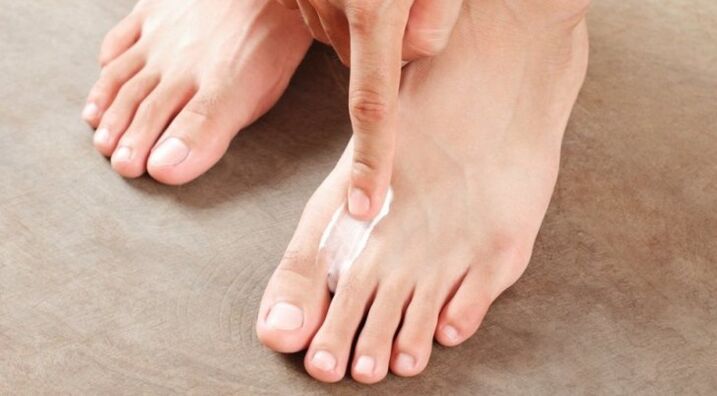Unbearable itching and reddening of the skin between the toes, cutting pain when walking are the first symptoms of the most common dermatological problem - fungal skin lesions. The mycelium of the fungus, which germinates through the delicate epithelium of the skin, gradually "spreads" over the entire plantar surface of the legs, causing uncomfortable moist and flaky areas, painful cracks and deformations of the nails.

Malignant fungus and related factors
The causative agent of the disease are dermatomycete fungi, among which the genus Trichophyton is considered the most common. They live almost everywhere - in pools and on beaches, in human shoes and on animal hair, but the disease is not always provoked. An important factor is the creation of a gate of infection through which the dermatomycete can penetrate to a sufficient depth.
The fungus between the toes occurs when the skin's barrier functions are weakened:
- When wearing tight, closed shoes. This is especially true during the hot season, when the released sweat creates conditions for the maceration of the skin and becomes the abode of many microorganisms.
- Abrasion and scratches are finished gates for the entry of fungi. If you have them, don't risk trying on someone else's shoes barefoot and walking barefoot in the pool, sauna and steam room.
- An effective remedy for the fungus on the feet between the toes must be sought by lovers of cheap pedicures in salons of dubious fame. The procedure itself involves cutting the cuticle and scrubbing the skin, and non-sterile instruments may well be "fortified" with fungus.
Fungus between the toes: symptoms and complications
What the fungus looks like on the legs between the toes can not be clearly described, since the disease has several forms, each of which is characterized by special manifestations:
- Dyshidrotic athlete's foot is characterized by three stages - reddening, blistering with liquid and drying crusts, peeling. As a rule, all three phases exist in the same places on the skin. The deceit of the dyshidrotic form of dermatomycosis lies in its close resemblance to eczema. A laboratory smear is required for an accurate diagnosis.
- The squamous epithelial shape is characterized by reddening and excessive flaking of the skin.
- A squamous cell hyperkeratosis lesion causes severe itching and burning, and seals and peeling scales appear a little later.
- With the intertriginous form, the manifestations are so typical that you do not even need to pay attention to what the fungus looks like between the toes in the photo: severe itching, burning is accompanied by peeling and the formation of painful cracks, and rather large foci ofepidermal peels are common.
- Intertriginous and dyshridrotic forms of dermatomycosis require caution and delicate methods of treatment, since the secondary microflora can easily penetrate into weeping foci and cracks, which leads to the appearance of abscesses. Despite the chronic course, they have pronounced inflammatory processes that require the use of emollient ointments and anti-inflammatory baths.
Drug treatment
There are a number of drugs in the arsenal of modern medicine used to treat fungus between the toes. These include both topical ointments and tablets that destroy the fungus from the inside. As a rule, a specialist selects a drug based on an analysis of the degree of development of the disease, its form and coverage. Systemic therapy with pills is used only in advanced cases, when the skin of the entire foot is involved in the process and characteristic changes are noted in the nail plates.
Antifungal ointments have been distributed over several generations. However, it is understood that even the most effective remedy for the fungus between the toes does not guarantee disposal if you neglect the rules of personal hygiene and a number of precautions.
A gentle pedicure should be performed at least once a week throughout the treatment. The frequency can then be reduced to every two weeks.
Since the fungus can survive on socks and shoes, they must also be treated. To do this, use liquids containing chlorine, such as bleach.
When thinking about how to get rid of fungus between your toes, make sure to change your socks every day. For two or three days in a row, when wearing clothing, traces of sweat remain, in which the parasites live and multiply.
Only a combination of a course of therapy selected by a specialist and careful compliance with all hygiene rules can ensure a quick recovery from the disease.
Treatment of the fungus between the toes with folk remedies
Traditional medicine has collected many recipes for fighting fungus, including products from kitchen cabinets, as well as very exotic herbs and medicines. The most accessible among them are:
- Iodine, daily lubrication of lesions, with which visible results are achieved in a week.
- Hydrogen peroxide, which gained popularity thanks to the work of a famous doctor. Its ability to destroy the fungus cell membranes and form a film on the surface of the damaged skin guarantees rapid relief from the disease.
When you've run up a lot of money and thinking about how to treat the fungus between your toes, you should also try the effects of vinegar. Although the fungus lives in a slightly acidic environment, it does not tolerate an increase in pH. Lubricating the affected areas with a solution of 9% vinegar and water in a ratio of 1: 8 gives positive results within 2-3 weeks.
The most popular remedies in folk medicine - onions and garlic - also have antifungal properties. The porridge prepared from it is mixed with petroleum jelly in a ratio of 1: 1 and applied to the affected skin before going to bed.
You haven't decided how to treat the fungus on your feet between your toes. Do not forget that it was destroyed on shoes and toiletries. This guarantees that relapses will not occur in the near future.































